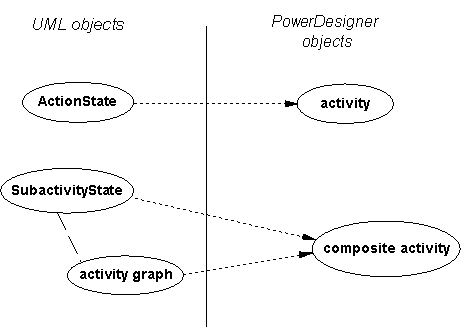

Chapter 5 Building Dynamic Diagrams
An activity is the invocation of a manual or automated action, such as "send a mail", or "increment a counter". When the activity gains control, it performs its action and then, depending on the result of the action, the transition (control flow) is passed to another activity.
An activity can be created in the following diagrams:
An activity can be atomic or decomposed:


You can use internal and external shortcuts of activities in your model.
A PowerDesigner activity is equivalent to a UML activity (ActionState or SubactivityState) and an activity graph. In UML, an ActionState represents the execution of an atomic action, and the SubactivityState is the execution of an activity graph (which is, in turn, the description of a complex action represented by sub-activities).
The following chart highlights UML vs PowerDesigner terminology and concepts:

In PowerDesigner, the combining of a SubactivityState and an activity graph into a decomposed activity allows you to define sub-activities directly under the parent activity without defining an additional object. If you do need to highlight the difference, you can create activities directly under the model or the package, and use activity shortcuts to detail the activity implementation. In this case, the SubactivityState corresponds to the shortcut of a decomposed activity.
| Copyright (C) 2006. Sybase Inc. All rights reserved. |

| |